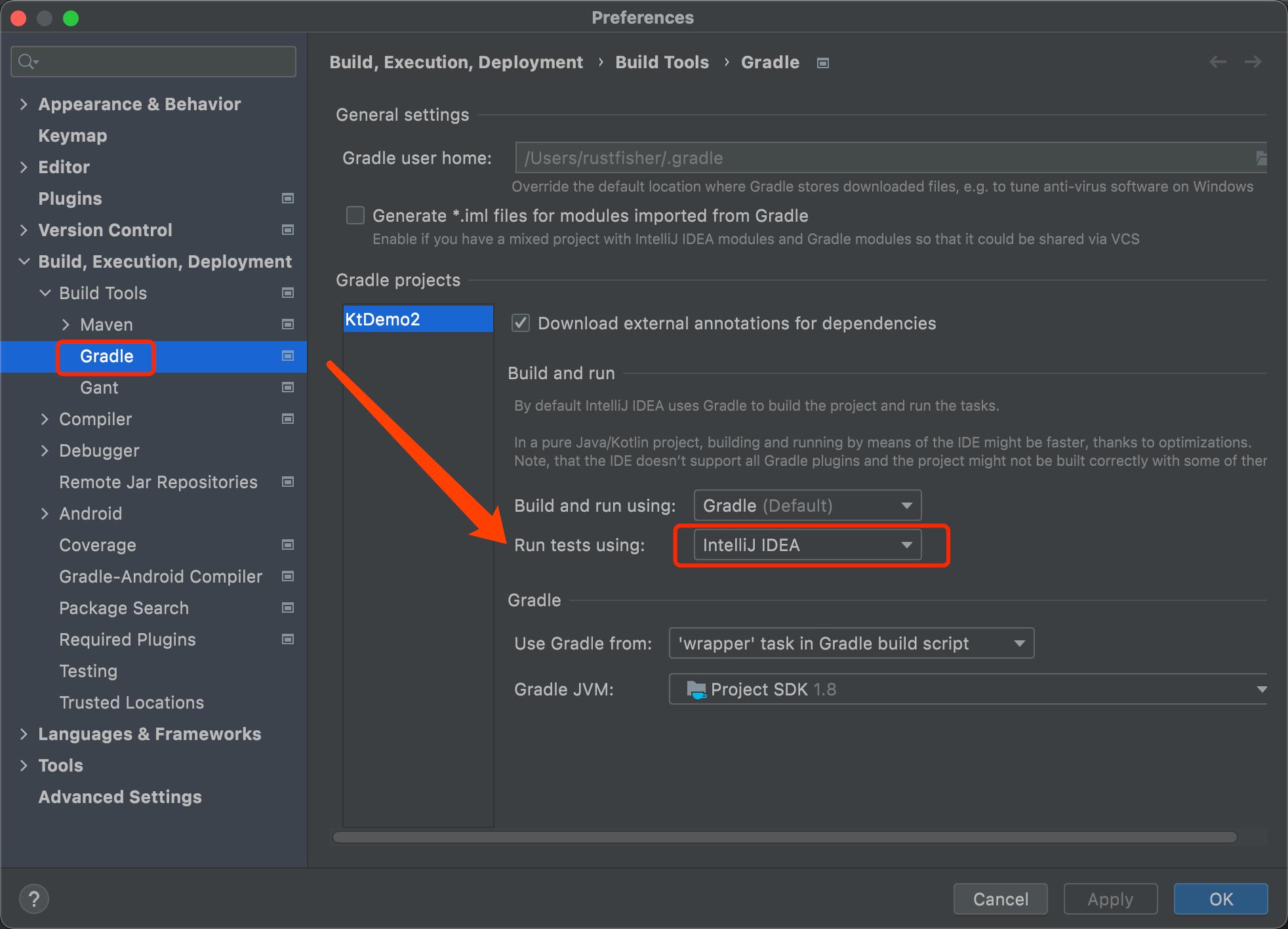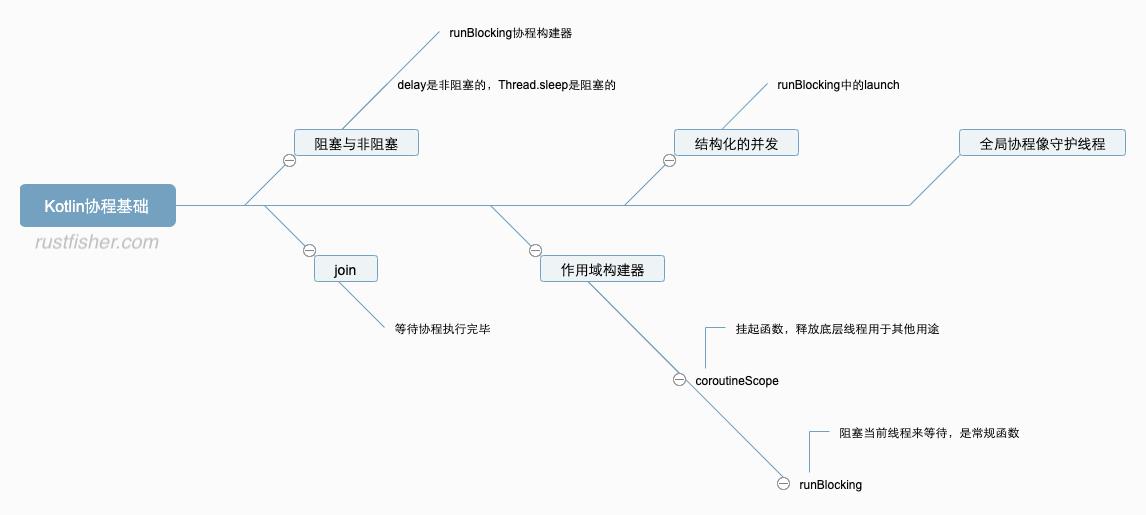Kotlin协程基础
Posted AnRFDev
tags:
篇首语:本文由小常识网(cha138.com)小编为大家整理,主要介绍了Kotlin协程基础相关的知识,希望对你有一定的参考价值。
开发环境
- IntelliJ IDEA 2021.2.2 (Community Edition)
- Kotlin: 212-1.5.10-release-IJ5284.40
我们已经通过第一个例子学会了启动协程,这里介绍一些协程的基础知识。
阻塞与非阻塞
runBlocking
delay是非阻塞的,Thread.sleep是阻塞的。显式使用 runBlocking 协程构建器来阻塞。
import kotlinx.coroutines.*
fun main() {
GlobalScope.launch { // 在后台启动一个新的协程并继续
delay(200)
"rustfisher.com".forEach {
print(it)
delay(280)
}
}
println("主线程中的代码会立即执行")
runBlocking { // 这个表达式阻塞了主线程
delay(3000L) //阻塞主线程防止过快退出
}
println("\\n示例结束")
}
可以看到,runBlocking里使用了delay来延迟。用了runBlocking的主线程会一直阻塞直到runBlocking内部的协程执行完毕。
也就是runBlocking{ delay }实现了阻塞的效果。
我们也可以用runBlocking来包装主函数。
import kotlinx.coroutines.*
fun main() = runBlocking {
delay(100) // 在这里可以用delay了
GlobalScope.launch {
delay(100)
println("Fisher")
}
print("Rust ")
delay(3000)
}
runBlocking<Unit>中的<Unit>目前可以省略。
runBlocking也可用在测试中
// 引入junit
dependencies {
implementation("junit:junit:4.13.1")
}
单元测试
使用@Test设置测试
import org.junit.Test
import kotlinx.coroutines.*
class C3Test {
@Test
fun test1() = runBlocking {
println("[rustfisher] junit测试开始 ${System.currentTimeMillis()}")
delay(1234)
println("[rustfisher] junit测试结束 ${System.currentTimeMillis()}")
}
}
运行结果
[rustfisher] junit测试开始 1632401800686
[rustfisher] junit测试结束 1632401801928
IDEA可能会提示no tasks available。需要把测试选项改为IDEA,如下图。

等待
有时候需要等待协程执行完毕。可以用join()方法。这个方法会暂停当前的协程,直到执行完毕。需要用main() = runBlocking。
import kotlinx.coroutines.*
fun main() = runBlocking {
println("[rustfisher]测试等待")
val job1 = GlobalScope.launch {
println("job1 start")
delay(300)
println("job1 done")
}
val job2 = GlobalScope.launch {
println("job2 start")
delay(800)
println("job2 done")
}
job2.join()
job1.join() // 等待
println("测试结束")
}
运行log
[rustfisher]测试等待
job1 start
job2 start
job1 done
job2 done
测试结束
结构化的并发
用GlobalScope.launch时,会创建一个顶层协程。之前的例子我们也知道,它不使用主线程。新创的协程虽然轻量,但仍会消耗一些内存资源。如果忘记保持对新启动的协程的引用,它还会继续运行。
我们可以在代码中使用结构化并发。
示例中,我们使用runBlocking协程构建器将main函数转换为协程。在里面(作用域)启动的协程不需显式使用join。
观察下面的例子:
import kotlinx.coroutines.*
fun main() = runBlocking<Unit> {
println("主线程id ${Thread.currentThread().id}")
launch { // 在 runBlocking 作用域中启动一个新协程1
println("协程1所在线程id ${Thread.currentThread().id}")
delay(300)
println("协程1执行完毕")
}
launch { // 在 runBlocking 作用域中启动一个新协程2
println("协程2所在线程id ${Thread.currentThread().id}")
delay(500)
println("协程2执行完毕")
}
println("主线程执行完毕")
}
运行log
主线程id 1
主线程执行完毕
协程1所在线程id 1
协程2所在线程id 1
协程1执行完毕
协程2执行完毕
可以看到,不用像之前那样调用Thread.sleep或者delay让主线程等待一段时间,防止虚拟机退出。
程序会等待它所有的协程执行完毕,然后真正退出。
作用域构建器
使用 coroutineScope 构建器声明自己的作用域。它会创建一个协程作用域,并且会等待所有已启动子协程执行完毕。
runBlocking 与 coroutineScope 看起来类似,因为它们都会等待其协程体以及所有子协程结束。主要区别在于:
runBlocking方法会阻塞当前线程来等待,是常规函数coroutineScope只是挂起,会释放底层线程用于其他用途,是挂起函数
下面这个示例展示了作用域构建器的特点。main是一个作用域。
import kotlinx.coroutines.*
fun main() = runBlocking { // this: CoroutineScope
launch {
delay(200L)
println("协程1 t${Thread.currentThread().id}")
}
coroutineScope { // 创建一个协程作用域
launch {
delay(500L)
println("内部协程2-1 t${Thread.currentThread().id}")
}
delay(100L)
println("协程2 t${Thread.currentThread().id}")
}
println("主任务完毕")
}
运行log
协程2 t1
协程1 t1
内部协程2-1t1
主任务完毕
提取函数重构
将launch { …… } 内部的代码块提取到独立的函数中。提取出来的函数需要 suspend 修饰符,它是挂起函数。
import kotlinx.coroutines.delay
import kotlinx.coroutines.launch
import kotlinx.coroutines.runBlocking
fun main() = runBlocking<Unit> {
launch { r1() }
println("DONE")
}
// 挂起函数
suspend fun r1() {
delay(300)
println("[rustfisher] 提取出来的函数")
}
log
DONE
[rustfisher] 提取出来的函数
协程是轻量的
我们前面也试过,创建非常多的协程,程序运行OK。
下面的代码可以输出很多的点
import kotlinx.coroutines.*
fun main() = runBlocking {
for (t in 1..10000) {
launch {
delay(t * 500L)
print(".")
}
}
}
全局协程像守护线程
我们在线程介绍中知道,如果进程中只剩下了守护线程,那么虚拟机会退出。
前文那个打印rustfisher.com的例子,其实也能看到,字符没打印完程序就结束了。
在 GlobalScope 中启动的活动协程并不会使进程保活。它们就像守护线程。
再举一个例子
import kotlinx.coroutines.*
fun main() = runBlocking {
GlobalScope.launch {
for (i in 1..1000000) {
delay(200)
println("协程执行: $i")
}
}
delay(1000)
println("Bye~")
}
log
协程执行: 1
协程执行: 2
协程执行: 3
协程执行: 4
Bye~
最后我们来看一下全文的思路

参考
以上是关于Kotlin协程基础的主要内容,如果未能解决你的问题,请参考以下文章
Kotlin 协程协程底层实现 ① ( Kotlin 协程分层架构 | 基础设施层 | 业务框架层 | 使用 Kotlin 协程基础设施层标准库 Api 实现协程 )